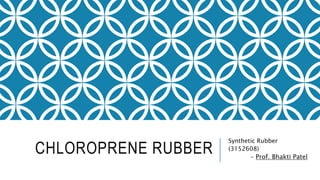
Chloroprene rubber (neoprene)
- 1. CHLOROPRENE RUBBER Synthetic Rubber (3152608) - Prof. Bhakti Patel
- 2. Manthan Sonani • 190280126033 Abhishek Sudani • 190280126034 Pratik Talaviya • 190280126035 Zadafiya Meet • 190280126039 Sandip Kanzariya • 190280126014 Jay Mavani • 190280126017 Jenish Savaliya • 190280126029 Parth Savani • 190280126030 Team members
- 3. INTRODUCTION Chloroprene rubber, whose nominal repeat unit is as shown at (XLV), has the distinction of being the earliest commercially-successful synthetic rubber. First introduced in 1932 by Du Pont under the trade name 'Duprene', later sold under the trade name 'Neoprene', and designated as GR~M (Government Rubber Monovinylacetylene) by the U.S. Government during World War II, it is still produced in quantity today by several large chemical companies, including Du Pont. It is a stereoregular rubber, being, in fact, largely trans-I,4- polychloroprene. It is therefore able to crystallise on stretching. In consequence, its gum vulcanizates have high tensile strength.
- 4. Its vulcanizates show moderate resistance to swelling in hydrocarbon oils and greases, combined with good resistance to low temperature stiffening. They also show good resistance to heat ageing, to oxidation and, in particular, to attack by ozone. The chemical resistance of the vulcanizates is also generally good. Chloroprene rubber is considerably more expensive than are the general-purpose hydrocarbon rubbers. Another reason is that, useful though the balance of properties offered by chloroprene rubber may be for some applications, there are many applications for which one particular property of chloroprene rubber is insufficiently developed. Thus, for instance, for many sealing applications, the resistance to swelling in hydrocarbon oils is inadequate. Or again, for other applications, the resistance to high temperature may be insufficient.
- 5. PRODUCTION OF CHLOROPRENE RUBBER Chloroprene rubber is produced exclusively by the free-radical emulsion polymerisation of chloroprene. It is possible to polymerise chloroprene by cationic initiation, by anionic initiation, and also by Ziegler-Natta catalysis, but the reactions take place more slowly than does free-radical polymerisation. Furthermore, the products of such reactions lack useful properties. Emulsion-polymerisation processes for the production of chloroprene rubber can be classified broadly into two types: I. Those in which control of the polymer molecular weight is achieved by copolymerisation with sulphur followed by reaction in which the polymer chains are cleaved at the sites where the sulphur is copolymerised 2. Those in which control of the polymer molecular weight is achieved by the inclusion within the polymerisation recipe of a chain transfer agent.
- 6. Chloroprene rubbers produced by the first type of process are usually described as being sulphur-modified, although they are also sometimes described as being thiuram- modified because, as will appear subsequently, the reagent which is commonly used to cleave the polychloroprene at the sulphur sites is a thiuram sulphide.
- 7. Chloroprene rubbers produced by the second of these processes are usually described rather negatively as being non-sulphur-modified. Little published information seems to be available concerning these latter types. It is known that at least some of them are produced using mercaptans as regulators of molecular weight. Grades produced in this way are described as being mercaptan- modified. When chloroprene is emulsion polymerised in the absence of either sulphur or a chain-transfer modifier, the product which forms even at low conversion is a tough, insoluble, non-plastic material. If sulphur to the extent of 0·5-1·5 % is dissolved in the chloroprene monomer prior to polymerisation, the product of the polymerisation is still a tough, insoluble material which is unsuitable for use as an elastomer.
- 8. Class Typical Acid Acceptor Metal oxides (1) High-activity magnesium oxide, MgO (2) Red lead, Pb3 O4 Vulcanizing Agent Zinc oxide Vulcanization Accelerator (1) Thioureas for W and T-types, sometimes G (2) Sulphur-based for W-types Vulcanization Retarder MBTS in G-Types, CBS, TMTD or MBTS in W-types Antioxidant Octylated diphenylamine Antiozonant Mixed diaryl-p-phenylene diamines with selected waxes, to 3 phr Fillers Carbon black; precipitated silica; calcium silicate; hydrated alumina; china clay Plasticizers Aromatic or naphthenic process oils; mono esters; polyester; chlorinated waxes Processing Aids Stearic acid; waxes ; low molecular weight polyethylene; high-cis polybutadiene; special factices Compounding Ingredients for Neoprene
- 9. Types G W T Raw Polymer Limited storage stability Excellent storage stability Excellent storage stability Polymer and compounds peptizable to varying degree Non-peptizable Need acceleration Least nerve, non- peptizable Fast curing but safe processing Best extrusion, calendaring performance Accelerators usually not necessary Need acceleration Vulcanizates Best tear strength Best compression set resistance Properties similar to W-types Best flex Best heat aging Best resilience Characteristics of Neoprene
- 10. PROPERTIES The chlorine in the polymer reduces the reactivity to many oxidizing agents and thus improves its chemical resistance. Due to its low reactivity, it displays good resistance to ozone cracking, heat aging and chemical attack. For example, it has good resistance to many chlorofluorocarbons, aliphatic hydrocarbons, mineral oils, greases and ozone, but only moderate or poor resistance to acids, solvents, and fuels. Its flame resistance is excellent. In fact, chloroprene is one of the few rubbers that are self- extinguishing. It also gives excellent rubber-to-metal bonds. However, chloroprene tends to harden over time and degrades in the presence of some fairly common chemicals such as hydrochloric acid, acetone, xylene, acetic acid, and hydrogen peroxide. Its mechanical properties are generally inferior to those of natural rubber but it has superior chemical resistance and lower gas permeability.
- 11. APPLICATION Chloroprene is used primarily for gaskets, cable jackets, tubing, seals, O-rings, tire- sidewalls, gasoline hoses and weather-resistant products such as wet suits and orthopaedic braces. It is also used as a base resin in adhesives, electrical insulations and coatings. It has many useful properties and a reasonable price. Its typical working temperature range is between -35°C and +100°C.
- 12. THANK YOU….